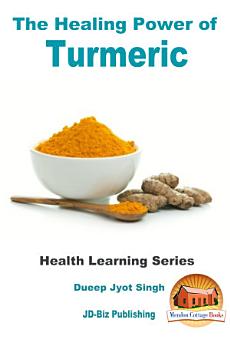The Healing Power of Turmeric
Jun 2016 · Mendon Cottage Books
4.4star
Maoni 7report
Kitabu pepe
50
Kurasa
family_home
Kimetimiza masharti
info
reportUkadiriaji na maoni hayajahakikishwa Pata Maelezo Zaidi
Kuhusu kitabu pepe hiki
Table of Contents
Introduction
Turmeric for Healing
Cultivation of Turmeric
Harvesting Time
Turmeric Diseases
Storing Fresh Turmeric
Turmeric for Beauty
Conclusion
The Danger of Online Incomplete Knowledge regarding the Usage of Natural Medicine, including Turmeric
Author Bio
Publisher
Introduction
In my previous books, where I have written extensively about herbs, especially when they are used for healing, in cuisine and for beauty, I have normally spoken about herbs which are found globally. However, thanks to the state-of-the-art transport system of the 21st century, I can talk about herbs, which were once unavailable to the common people in other lands and native to only just one particular part of the globe. And that is the reason why the healing qualities of many local and native herbs, like ginseng, lemongrass, and other such herbs, which were possibly not available to people in other corners of the earth were overlooked for centuries.
But that is definitely not the situation today. You can walk into any city market and request spices from all corners of the world and you just have to ask and you will be given. And that is why today, we are going to be talking about one of the most powerful healing herbs available in the world today, to mankind, turmeric.
Turmeric belongs to the ginger family, and it is a rhizome. It originated in the southwest part of the Indian subcontinent millenniums ago, and nobody really knows which particular civilization found out that this rhizome dug up from the ground, could be used fresh, to impart a golden color to anything, food, clothes, and skin!
Being a native of a tropical region, turmeric needs lots of rain. The average temperature outside has to be around 20°C – 30°C, for this particular plant to survive.
When I was a child, I often saw one of our gardeners who also was a native herbalist going out into the woods and coming back triumphantly with these dug up rhizomes in her hand. They looked like ordinary ginger to me. So that is when I found out that these rhizomes were boiled for about 45 minutes and then allowed to dry in the sun in the shade for about 3 – 4 days. And after that the dried rhizomes would be ground in a pestle and mortar, to give a deep natural, yellow – orange powder, which was precious turmeric.
Introduction
Turmeric for Healing
Cultivation of Turmeric
Harvesting Time
Turmeric Diseases
Storing Fresh Turmeric
Turmeric for Beauty
Conclusion
The Danger of Online Incomplete Knowledge regarding the Usage of Natural Medicine, including Turmeric
Author Bio
Publisher
Introduction
In my previous books, where I have written extensively about herbs, especially when they are used for healing, in cuisine and for beauty, I have normally spoken about herbs which are found globally. However, thanks to the state-of-the-art transport system of the 21st century, I can talk about herbs, which were once unavailable to the common people in other lands and native to only just one particular part of the globe. And that is the reason why the healing qualities of many local and native herbs, like ginseng, lemongrass, and other such herbs, which were possibly not available to people in other corners of the earth were overlooked for centuries.
But that is definitely not the situation today. You can walk into any city market and request spices from all corners of the world and you just have to ask and you will be given. And that is why today, we are going to be talking about one of the most powerful healing herbs available in the world today, to mankind, turmeric.
Turmeric belongs to the ginger family, and it is a rhizome. It originated in the southwest part of the Indian subcontinent millenniums ago, and nobody really knows which particular civilization found out that this rhizome dug up from the ground, could be used fresh, to impart a golden color to anything, food, clothes, and skin!
Being a native of a tropical region, turmeric needs lots of rain. The average temperature outside has to be around 20°C – 30°C, for this particular plant to survive.
When I was a child, I often saw one of our gardeners who also was a native herbalist going out into the woods and coming back triumphantly with these dug up rhizomes in her hand. They looked like ordinary ginger to me. So that is when I found out that these rhizomes were boiled for about 45 minutes and then allowed to dry in the sun in the shade for about 3 – 4 days. And after that the dried rhizomes would be ground in a pestle and mortar, to give a deep natural, yellow – orange powder, which was precious turmeric.
Ukadiriaji na maoni
4.4
Maoni 7
Kuhusu mwandishi
John Davidson
Born and raised in Wyoming and Canada on Ranches. Studied at Utah State University and taught drafting at Bridgerland Applied Technology College for 20 years. Own and run several businesses, an architectural design business, a web design business and a Sawmill business. Married to Karla for over 30 years and have 4 great kids, living in Mendon, Utah.Kadiria kitabu pepe hiki
Tupe maoni yako.
Kusoma maelezo
Simu mahiri na kompyuta vibao
Sakinisha programu ya Vitabu vya Google Play kwa ajili ya Android na iPad au iPhone. Itasawazishwa kiotomatiki kwenye akaunti yako na kukuruhusu usome vitabu mtandaoni au nje ya mtandao popote ulipo.
Kompyuta za kupakata na kompyuta
Unaweza kusikiliza vitabu vilivyonunuliwa kwenye Google Play wakati unatumia kivinjari cha kompyuta yako.
Visomaji pepe na vifaa vingine
Ili usome kwenye vifaa vya wino pepe kama vile visomaji vya vitabu pepe vya Kobo, utahitaji kupakua faili kisha ulihamishie kwenye kifaa chako. Fuatilia maagizo ya kina ya Kituo cha Usaidizi ili uhamishe faili kwenye visomaji vya vitabu pepe vinavyotumika.








